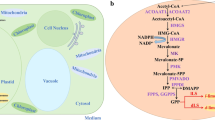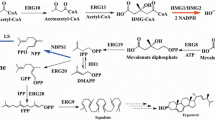Abstract
R-(+)-Perillic acid, a promising anticancer and immunomodulatory agent, is the major product from the biotransformation of R-(+)-limonene-rich orange essential oil by the yeast Yarrowia lipolytica. Due to the abundance and low cost of orange essential oil, which is a byproduct of the citrus industry, we attempted to improve the biotransformation process by optimizing yeast cell mass production. Then, the whole process was transposed and adapted to a 2-L instrumented bioreactor. Cell mass production was optimized in shaker flasks using a statistical experimental design. The optimized medium (g·L−1: 22.9 glucose, 7.7 peptone, 4.1 yeast extract and 1.0 malt extract) resulted in a 13.0 g·L−1 final cell concentration and 0.18 g cell·L−1·h−1 productivity. A further increase to 18.0 g·L−1 was achieved in a 2-L bioreactor upon fed-batch culture. High-purity limonene bioconversion was performed in the same bioreactor utilizing top aeration to diminish terpene volatilization; as a result, 839.6 mg·L−1 perillic acid accumulated after 48 h. Under the same conditions, industrial orange essential oil afforded 806.4 mg·L−1 perillic acid. The yeast growth medium optimization resulted in a twofold increase in biomass accumulation and a reduction in growth medium nitrogen sources, which lowered the catalytic biomass production cost. Compared with conventional bottom aeration, the bioreactor top aeration strategy resulted in higher bioconversion rates. The conditions developed for high-purity limonene bioconversion were successfully applied to low-cost orange essential oil, showing the robustness of Y. lipolytica yeast.




Similar content being viewed by others
Data availability
All data generated or analysed during this study are included in this published article.
References
Sun J (2007) D-Limonene: safety and clinical applications. Altern Med Rev 12:259–264
Ariazi EA, Satomi Y, Ellis MJ, Haag JD, Shi W, Sattler CA, Gould MN (1999) Activation of the transforming growth factor beta signaling pathway and induction of cytostasis and apoptosis in mammary carcinomas treated with the anticancer agent perillyl alcohol. Cancer Res 59:1917–1928
Tsai KD, Liu YH, Chen TW, Yang SM, Wong HY, Cherng J, Chou KS, Cherng JM (2016) Cuminaldehyde from Cinnamomum verum induces cell death through targeting topoisomerase 1 and 2 in human colorectal adenocarcinoma COLO 205 cells. Nutrients 8:318. https://doi.org/10.3390/nu8060318
Hardcastle I, Rowlands M, Barber AM, Grimshaw R, Mohan M, Nutley B, Jarman M (1999) Inhibition of protein prenylation by metabolites of limonene. Biochem Pharmacol 57:801–809. https://doi.org/10.1016/s0006-2952(98)00349-9
Mukhtar YM, Adu-Frimpong M, Xu X, Yu J (2018) Biochemical significance of limonene and its metabolites: future prospects for designing and developing highly potent anticancer drugs. Biosci Rep 38. https://doi.org/10.1042/BSR20181253
Yeruva L, Pierre KJ, Elegbede A, Wang RC, Carper SW (2007) Perillyl alcohol and perillic acid induced cell cycle arrest and apoptosis in non-small cell lung cancer cells. Cancer Lett 257:216–226. https://doi.org/10.1016/j.canlet.2007.07.020
Lappas CM, Lappas NT (2012) D-Limonene modulates T lymphocyte activity and viability. Cell Immunol 279:30–41. https://doi.org/10.1016/j.cellimm.2012.09.002
Del Toro-Arreola S, Flores-Torales E, Torres-Lozano C, Del Toro-Arreola A, Tostado-Pelayo K, Ramirez-Dueñas MG, Daneri-Navarro A (2005) Effect of D-limonene on immune response in BALB/c mice with lymphoma. Int Immunopharmacol 5:829–838. https://doi.org/10.1016/j.intimp.2004.12.012
Marmulla R, Harder J (2014) Microbial monoterpene transformations-a review. Front Microbiol 5:346. https://doi.org/10.3389/fmicb.2014.00346
Grabarczyk M, Mączka W, Żołnierczyk AK, Wińska K (2020) Transformations of monoterpenes with the p-menthane skeleton in the enzymatic system of bacteria, fungi and insects. Molecules 25:4840. https://doi.org/10.3390/molecules25204840
Duetz WA, Bouwmeester H, Van Beilen JB, Witholt B (2003) Biotransformation of limonene by bacteria, fungi, yeasts, and plants. Appl Microbiol Biotechnol 61:269–277. https://doi.org/10.1007/s00253-003-1221-y
Van Beilen JB, Holtackers R, Lüscher D, Bauer U, Witholt B, Duetz WA (2005) Biocatalytic production of perillyl alcohol from limonene by using a novel Mycobacterium sp. cytochrome P450 alkane hydroxylase expressed in Pseudomonas putida. Appl Environ Microbiol 71:1737–1744. https://doi.org/10.1128/AEM.71.4.1737-1744.2005
Mirata MA, Heerd D, Schrader J (2009) Integrated bioprocess for the oxidation of limonene to perillic acid with Pseudomonas putida DSM 12264. Process Biochem 44:764–771. https://doi.org/10.1016/j.procbio.2009.03.013
Van Rensburg E, Molekeli N, Van Der Walt JP, Botes PJ, Van Dyk MS (1997) Biotransformation of (+) limonene and (−) piperitone by yeasts and yeast-like fungi. Biotechnol Lett 19:779–782. https://doi.org/10.1023/A:1018344411069
Szczesna-Skorupa E, Chen C, Liu H, Kemper B (2004) Gene expression changes associated with the endoplasmic reticulum stress response induced by microsomal cytochrome P450 overproduction. J Biol Chem 279:13953–13961. https://doi.org/10.1074/jbc.M312170200
Linder T (2019) Taxonomic distribution of cytochrome P450 monooxygenases (CYPs) among the budding yeasts (sub-phylum Saccharomycotina). Microorganisms 7:247. https://doi.org/10.3390/microorganisms7080247
Ferrara MA, Almeida DS, Siani AC, Lucchetti L, Lacerda PSB, Freitas A, Tappin MR, Bon EPS (2013) Bioconversion of R-(+)-limonene to perillic acid by the yeast Yarrowia lipolytica. Braz J Microbiol 44:1075–1080. https://doi.org/10.1590/S1517-83822014005000008
Tappin MRR, Knopp FM, Cardoso IC, Santos RT, Drummond BS, Siani AC, Bon EPS, Ferrara MA (2017) Synthesis of the prospective anticancer molecule perillic acid from orange essential oil by the yeast Yarrowia lipolytica. Green Sustain Chem 7:172–184. https://doi.org/10.4236/gsc.2017.72013
Pescheck M, Mirata MA, Brauer B, Krings U, Berger RG, Schrader J (2009) Improved monoterpene biotransformation with Penicillium sp. by use of a closed gas loop bioreactor. J Ind Microbiol Biotechnol 36:827–836. https://doi.org/10.1007/s10295-009-0558-3
Workman M, Holt P, Thykaer J (2013) Comparing cellular performance of Yarrowia lipolytica during growth on glucose and glycerol in submerged cultivations. AMB Expr 3:58. https://doi.org/10.1186/2191-0855-3-58
Cordova LT, Butler J, Alper HS (2020) Direct production of fatty alcohols from glucose using engineered strains of Yarrowia lipolytica. Metab Eng Commun 10:e00105. https://doi.org/10.1016/j.mec.2019.e00105
Galvão JG, Silva VF, Ferreira SG, França FRM, Santos DA, Freitas LS, Alves PB, Araujo AAS, Cavalcanti SCH, Nunes RS (2015) β-cyclodextrin inclusion complexes containing Citrus sinensis (L.) Osbeck essential oil: An alternative to control Aedes aegypti larvae. Thermochim Acta 608:14–19. https://doi.org/10.1016/j.tca.2015.04.001
Negro V, Mancini G, Ruggeri B, Fino D (2016) Citrus waste as feedstock for bio-based products recovery: review on limonene case study and energy valorization. Biores Technol 214:806–815. https://doi.org/10.1016/j.biortech.2016.05.006
Kringel DH, Antunes MD, Klein B, Crizel LR, Wagner R, Oliveira RP, Dias ARG, Zavareze ER (2017) Production, characterization, and stability of orange or eucalyptus essential oil/β-cyclodextrin inclusion complex. J Food Sci 82:2598–2605. https://doi.org/10.1111/1750-3841.13923
Kunjapur AM, Prather KLJ (2015) Microbial engineering for aldehyde synthesis. Appl Environ Microbiol 81:1892–1901. https://doi.org/10.1128/AEM.03319-14
Marostica MR Jr, Pastore GM (2007) Biotransformation of limonene: a review of the main metabolic pathways. Quim Nova 30:382–387. https://doi.org/10.1590/S0100-40422007000200027
Palmerín-Carreño DM, Rutiaga-Quiñones OM, Verde-Calvo JR, Prado-Barragán A, Huerta-Ochoa S (2016) Whole cell bioconversion of (+)-valencene to (+)-nootkatone in 100% organic phase using Yarrowia lipolytica 2.2ab. Int J Chem React Eng 29:36–45. https://doi.org/10.1515/ijcre-2016-0013
Kruhne U, Heintz S, Ringborg R, Rosinha IP, Tufvesson P, Gernaey KV, Woodley JM (2014) Biocatalytic process development using microfluidic miniaturized systems. Green Process Synth 3:23–31. https://doi.org/10.1515/gps-2013-0089
FAO (2021) Citrus Fruit Statistical Compendium 2020. Rome. Food and Agriculture Organization of the United Nations. https://www.fao.org/3/cb6492en/cb6492en.pdf. Accessed 22 March 2022
Ferreira-Leitão V, Gottschalk LMF, Ferrara MA, Nepomuceno AL, Molinari HBC, Bon EPS (2010) Biomass residues in Brazil: availability and potential uses. Waste Biomass Valorization 1:65–76. https://doi.org/10.1007/s12649-010-9008-8
Acknowledgements
The authors are grateful to Daniel Santos Pereira and Maria Alice Santos Cerullo for the HPLC analysis and to Lucas Tupi Caldas Pereira for the valuable assistance in the bioreactor experiments.
Funding
This work was supported by the National Council for Scientific and Technological Development (CNPq) and the Pharmaceutical Technology Institute of the Oswaldo Cruz Foundation under grant PROEP/FAR/CNPq 407841/2017–2; Carlos Chagas Filho Foundation for Research Support of the State of Rio de Janeiro (FAPERJ) under grants E-26/110.856/2013 and E-26/101.210/2013; CNPq under grant 307766/2014/4; and PIBIC/CNPq/FIOCRUZ 2014–2016.
Author information
Authors and Affiliations
Contributions
F.M. Knopp contributed to the design of the studies, performed the experiments, analysed the experimental data, and contributed to writing the manuscript; R.R.O. Barros contributed to the design of the optimization studies and the critical revision of the manuscript; B.S. Drummond contributed to the performance of the experiments; A.C. Siani acquired funding for this work and contributed to the critical revision of the manuscript; M.A. Ferrara contributed to the supervision, conception and design of the studies and writing of the manuscript; E.P.S. Bon contributed to the supervision, provided lab space, acquired funding for this work and contributed to the critical revision of the manuscript.
All authors read and approved the final manuscript.
Corresponding author
Ethics declarations
Ethics approval
This article does not contain any studies with human participants or animals performed by any of the authors.
Consent to participate
Not applicable.
Consent for publication
Not applicable.
Competing interest
The authors declare no competing interests.
Conflict of interest
The authors report no conflict of interest.
Additional information
Responsible Editor: Rosane Freitas Schwan
Publisher's note
Springer Nature remains neutral with regard to jurisdictional claims in published maps and institutional affiliations.
Supplementary Information
Below is the link to the electronic supplementary material.
Rights and permissions
Springer Nature or its licensor (e.g. a society or other partner) holds exclusive rights to this article under a publishing agreement with the author(s) or other rightsholder(s); author self-archiving of the accepted manuscript version of this article is solely governed by the terms of such publishing agreement and applicable law.
About this article
Cite this article
Knopp, F.M., da Rocha Olivieri de Barros, R., Drummond, B.S. et al. Production of perillic acid from orange essential oil by Yarrowia lipolytica using a top-aerated bioreactor. Braz J Microbiol 54, 2663–2670 (2023). https://doi.org/10.1007/s42770-023-01108-w
Received:
Accepted:
Published:
Issue Date:
DOI: https://doi.org/10.1007/s42770-023-01108-w




